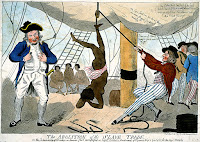“It matters that the overall magnitude of the African diaspora is now quite definitely known: that…eleven million Africans were forcibly carried abroad, more than nine million of them to the Americas. It matters—it stretches the imagination to visualize—that at the height of the British slave trade, in the 1790s, one large slave vessel left England for Africa every other day. It matters that slave rebellions occurred on approximately 10 percent of all slave ships, that 10 percent of the slaves on such voyages were killed in the insurrections (which totals 100,000 deaths, 1500–1867), and that the fear of insurrection increased shipboard staffing and other expenses on the Middle Passage by 18 percent, costs that if invested in enlarged shipments would have led to the enslavement of one million more Africans than were actually forced into the system over the course of the long eighteenth century. It matters that the incidence of revolts did not increase with the decline in crew size, hence that slave-centered factors determined the uprisings. It matters that shore-based attacks on European slave ships were twenty times more likely in the Senegal and Gambia River areas than elsewhere in Atlantic Africa. It matters that shipboard mortality (only 50 percent of all slave deaths—the rest occurred in Africa or at embarkation) did not increase with the length of the voyages or with the number of slaves per ship (‘tighter packing’) but did vary according to African ports of departure. It matters that French slave ships left Africa with an average load of close to 320 captives; that one such vessel sailed with 900 slaves; that another lost 408 Africans on a single Atlantic voyage; that 92 percent of the ‘cargo’ on another French vessel were children; and that the average number of captives on French vessels rose from 261 in the seventeenth century to 340 at the end of the eighteenth century. It is astonishing simply to attempt to visualize the consequences of the fact that in one year, 1790, French ships landed at least 40,000 slaves on the small island of St. Domingue, 19,000 of them (equal to the entire population of contemporary Boston) at the small port of Cap Français—and to consider the profound effect that fact must have had.”—Pulitzer Prize-winning American historian Bernard Bailyn (1922-2020), “Considering the Slave Trade,” in Sometimes an Art: Nine Essays on History (2015)
The image accompanying this post, “The Abolition of the Slave Trade,” an engraving by Isaac Cruikshank, shows British Captain John Kimber on the deck of the Recovery, with the girl he was alleged to have whipped to death.
More than two centuries after it was published, the picture still has the power to shock—but, in another sense, how could it have been worse than the above facts cited by Bailyn--or, for that matter, the resistance of so many in the United States to educating students why slavery was so horrendous and yet so persistent?
Kimber was acquitted of
the girl’s murder after a trial in 1792, but the case was instrumental in
mobilizing public opinion behind William Wilberforce’s campaign to outlaw the
slave trade in the British Empire. It would take a bloody civil war to end
slavery in the United States, but we are living still with its consequences.

No comments:
Post a Comment